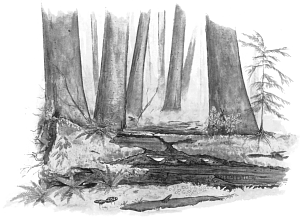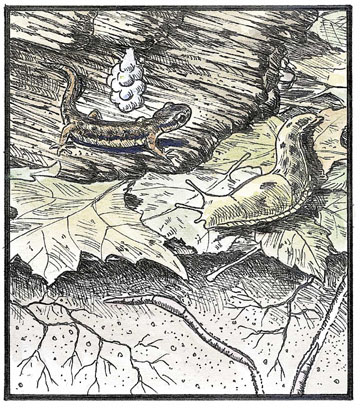3.5 Forest floor
Learner outcomes
On completion of part 3D, you will understand the role that the stand level component — forest floor — plays in forest biodiversity and you will be able to:
- Describe the components of a forest floor
- Identify forest management applications for forest floor
- Describe the role of forest floor in forest biodiversity
General information about forest floor
Forest floor includes humus, decomposing materials, and freshly deposited leaf litter. Forest floor provides suitable habitat for a diverse community of invertebrates including nematodes, roundworms, and arthropods. These in turn play an important role as decomposers and as a food source for a variety of vertebrates such as shrews, which forage on the ground. It supports a variety of saprophytic plants, bacteria, and fungi that aid in decomposition processes and nutrient cycling with the rootlets of trees and shrubs.
These in turn play an important role as decomposers and as a food source for a variety of vertebrates such as shrews, which forage on the ground. It supports a variety of saprophytic plants, bacteria, and fungi that aid in decomposition processes and nutrient cycling with the rootlets of trees and shrubs.
Numerous soil fungi, called mycorrhizae, form essential symbiotic relationships (nutrient uptake transfer) with the rootlets of most tree and shrub species found in BC. Several million bacteria, tens of thousands of fungal propagules, and several kilometres of fungal strands (hyphae) can be present in a single gram of soil.
For more information on soil biodiversity, see Appendix 1 (Soil biodiversity)

- What role does forest floor play in forest biodiversity?
The presence of surface organic matter affects soil water holding capacity, aeration, drainage, and cation exchange. The forest floor contains nutrients that are important in maintaining long-term site productivity.
Forest floors play a major role in determining the vegetative composition of ecosystems through impacts on soil structure, nutrient spectrum, organic matter content, water retention and drainage, and pH. Forest practices that minimize soil disturbance are the best way to maintain belowground biodiversity and ensure the continued functioning of the soil ecosystem.
- What else do you know about this topic?
Maintain soil integrity by minimizing:
- Compaction
- Displacement (loss of organic matter)
- Loss to erosion and wasting
- The removal of wildlife tree patches (containing intact forest floor)
- Piling and burning
Applications to forest management
Maintain soil and forest floor integrity by minimizing:
- Disturbance to the forest floor during harvesting
- Compaction
- Displacement (loss of organic matter)
- Loss to erosion and wasting
- Disturbance of reserve areas, including wildlife tree patches
- Piling and burning
- Are there other applications? If so, list them. Explain each of these terms
Forest floor - conclusion
Review of learner outcomes
- Are you able to describe forest floor?
- Are you able to identify forest management applications for forest floor?
- Can you describe the role of forest floor in forest biodiversity?
Use a ladder diagram to post your ideas. If you cannot complete these questions, what will you do so that you are able to? A ladder diagram allows you to add as many roles and as much detail as you wish. Just add as many lines as you need. Limit each detail to one word or one statement. It is possible to continue the ladder pattern with related details.
Transfer of learning
What did I learn in Part 3D that I can use in other aspects of my job?
Reflections
How does the information in Part 3D tie in with what I already knew about forest floor?




